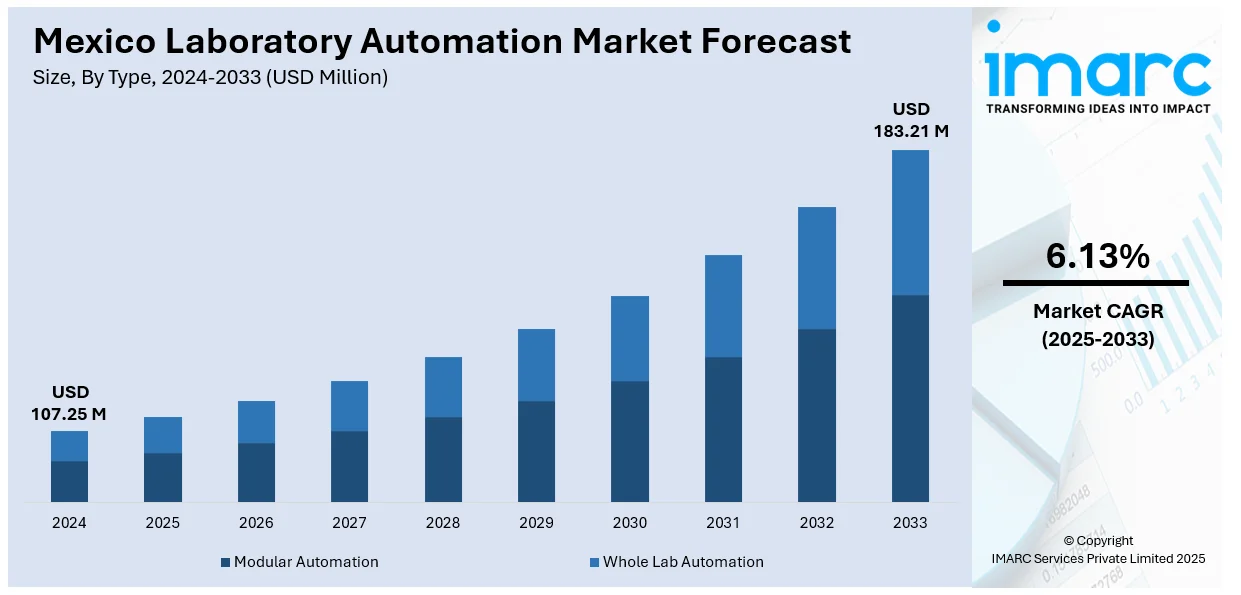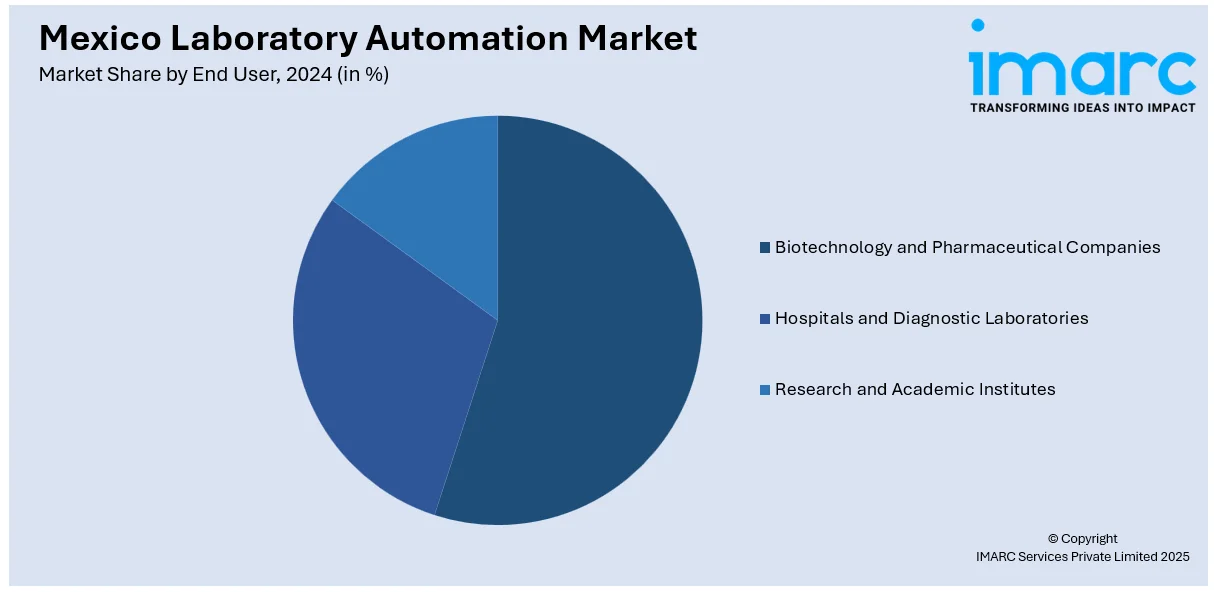
Mexico Laboratory Automation Market Size, Share, Trends and Forecast by Type, Equipment and Software Type, End User, and Region, 2025-2033
Mexico Laboratory Automation Market Overview:
The Mexico laboratory automation market size reached USD 107.25 Million in 2024. Looking forward, IMARC Group expects the market to reach USD 183.21 Million by 2033, exhibiting a growth rate (CAGR) of 6.13% during 2025-2033. The demand for efficient diagnostics, expansion in pharmaceutical research, and application of new technologies like artificial intelligence, drives the market. Initiatives by government to upgrade healthcare infrastructure and increase R&D spending further stimulates the shift toward automation in clinical, industrial, and academic lab settings.
|
Report Attribute
|
Key Statistics
|
|---|---|
|
Base Year
|
2024 |
|
Forecast Years
|
2025-2033
|
|
Historical Years
|
2019-2024
|
| Market Size in 2024 | USD 107.25 Million |
| Market Forecast in 2033 | USD 183.21 Million |
| Market Growth Rate 2025-2033 | 6.13% |
Mexico Laboratory Automation Market Trends:
Advanced Technologies Integration
The Mexico laboratory automation market outlook reflects the integration of technologies such as AI, machine learning, and the IoT. AI and ML are also being employed further owing to their data analysis capabilities through which laboratories can analyze complicated data sets with enhanced precision and speed. These technologies enable predictive analytics, pattern discovery, and automation of decision-making routines paving the way to streamlined workflows with better research outcomes. At the same time, IoT-enabled lab instruments allow real-time data sharing and remote monitoring, increasing connectivity and operational efficiency. The convergence of these technologies effectively turns a traditional laboratory environment into an intelligent responsive system, thus fostering innovation and pushing forward scientific discoveries across sectors such as healthcare, pharmaceuticals, and biotechnology.

Expansion to Various Applications
Implementation of lab automation is expanding different applications in Mexico, reflecting the mounting emphasis on research and development within the nation. Automated systems find several applications in clinical diagnostics, drug development, genomics, and environmental testing, among others, which further fuel the Mexico laboratory automation market growth. In clinical diagnostics, automation speeds up the testing process, allowing for the rapid identification of patients and improved provision of health care. Automating the drug discovery workflow allows high-throughput screening and data analysis to be conducted, further accelerating the identification of candidates with therapeutic potential. In genomics, automation enables large-scale sequencing and analysis to complement personalized medicine initiatives. Thus, the varied applications show the flexibility and advantages of laboratory automation to meet the diverse needs of Mexico's science and health sectors.
Government Support and Policy Initiatives
The Mexican government plays a significant role in the promotion of laboratory automation, while implementing profitable policies and programs for improving healthcare and research infrastructure. The government-funded programs are favoring advanced technologies usage in laboratories and facilitating access to funds through building public-private partnerships. The policies essentially aim at increasing laboratory productivity and performance, precision diagnostics, and development of scientific research. Being in line with the global trends of laboratory automation, this region is hence emerging as a strong competing force in Latin America, attracting several foreign and local investments, thus increasing the Mexico laboratory automation market share.
Mexico Laboratory Automation Market Segmentation:
IMARC Group provides an analysis of the key trends in each segment of the market, along with forecasts at the country and regional levels for 2025-2033. Our report has categorized the market based on type, equipment and software type, and end user.
Type Insights:
- Modular Automation
- Whole Lab Automation
The report has provided a detailed breakup and analysis of the market based on the type. This includes modular automation and whole lab automation.
Equipment and Software Type Insights:
- Automated Clinical Laboratory Systems
- Workstations
- LIMS (Laboratory Information Management Systems)
- Sample Transport Systems
- Specimen Handling Systems
- Storage Retrieval Systems
- Automated Drug Discovery Laboratory Systems
- Plate Readers
- Automated Liquid Handling Systems
- LIMS (Laboratory Information Management Systems)
- Robotic Systems
- Storage Retrieval Systems
- Dissolution Testing Systems
The report has provided a detailed breakup and analysis of the market based on the equipment and software type. This includes automated clinical laboratory systems [workstations, LIMS (laboratory information management systems), sample transport systems, specimen handling systems, storage retrieval systems] and automated drug discovery laboratory systems [plate readers, automated liquid handling systems, LIMS (laboratory information management systems), robotic systems, storage retrieval systems, dissolution testing systems].
End User Insights:

- Biotechnology and Pharmaceutical Companies
- Hospitals and Diagnostic Laboratories
- Research and Academic Institutes
The report has provided a detailed breakup and analysis of the market based on the end user. This includes biotechnology and pharmaceutical companies, hospitals and diagnostic laboratories, and research and academic institutes.
Regional Insights:
- Northern Mexico
- Central Mexico
- Southern Mexico
- Others
The report has also provided a comprehensive analysis of all the major regional markets, which include Northern Mexico, Central Mexico, Southern Mexico and others.
Competitive Landscape:
The market research report has also provided a comprehensive analysis of the competitive landscape. Competitive analysis such as market structure, key player positioning, top winning strategies, competitive dashboard, and company evaluation quadrant has been covered in the report. Also, detailed profiles of all major companies have been provided.
Mexico Laboratory Automation Market News:
- In February 2025, the installation of the first Copan WASPLab® full lab automation system in Latin America was a major accomplishment for Hospital Angeles Pedregal in Mexico City. A ribbon-cutting event uniting hospital leaders, Copan, and representatives from distribution partner bioMérieux Mexico was held to commemorate this progress in laboratory innovation. WASPLab® is an efficient, modular, and adaptable system for processing specimens and conducting culture workups in clinical microbiology. Samples transition from initial processing to intelligent incubation, digital microbiology, and AI for plate analysis. The system optimizes processes to improve productivity.
Mexico Laboratory Automation Market Report Coverage:
| Report Features | Details |
|---|---|
| Base Year of the Analysis | 2024 |
| Historical Period | 2019-2024 |
| Forecast Period | 2025-2033 |
| Units | Million USD |
| Scope of the Report | Exploration of Historical Trends and Market Outlook, Industry Catalysts and Challenges, Segment-Wise Historical and Future Market Assessment:
|
| Types Covered | Modular Automation, Whole Lab Automation |
| Equipment and Software Types Covered |
|
| End Users Covered | Biotechnology and Pharmaceutical Companies, Hospitals and Diagnostic Laboratories, Research and Academic Institutes |
| Regions Covered | Northern Mexico, Central Mexico, Southern Mexico, Others |
| Customization Scope | 10% Free Customization |
| Post-Sale Analyst Support | 10-12 Weeks |
| Delivery Format | PDF and Excel through Email (We can also provide the editable version of the report in PPT/Word format on special request) |
Key Questions Answered in This Report:
- How has the Mexico laboratory automation market performed so far and how will it perform in the coming years?
- What is the breakup of the Mexico laboratory automation market on the basis of type?
- What is the breakup of the Mexico laboratory automation market on the basis of equipment and software type?
- What is the breakup of the Mexico laboratory automation market on the basis of end user?
- What is the breakup of the Mexico laboratory automation market on the basis of region?
- What are the various stages in the value chain of the Mexico laboratory automation market?
- What are the key driving factors and challenges in the Mexico laboratory automation market?
- What is the structure of the Mexico laboratory automation market and who are the key players?
- What is the degree of competition in the Mexico laboratory automation market?
Key Benefits for Stakeholders:
- IMARC’s industry report offers a comprehensive quantitative analysis of various market segments, historical and current market trends, market forecasts, and dynamics of the Mexico laboratory automation market from 2019-2033.
- The research report provides the latest information on the market drivers, challenges, and opportunities in the Mexico laboratory automation market.
- Porter's five forces analysis assist stakeholders in assessing the impact of new entrants, competitive rivalry, supplier power, buyer power, and the threat of substitution. It helps stakeholders to analyze the level of competition within the Mexico laboratory automation industry and its attractiveness.
- Competitive landscape allows stakeholders to understand their competitive environment and provides an insight into the current positions of key players in the market.
Need more help?
- Speak to our experienced analysts for insights on the current market scenarios.
- Include additional segments and countries to customize the report as per your requirement.
- Gain an unparalleled competitive advantage in your domain by understanding how to utilize the report and positively impacting your operations and revenue.
- For further assistance, please connect with our analysts.
 Request Customization
Request Customization
 Speak to an Analyst
Speak to an Analyst
 Request Brochure
Request Brochure
 Inquire Before Buying
Inquire Before Buying




.webp)




.webp)












